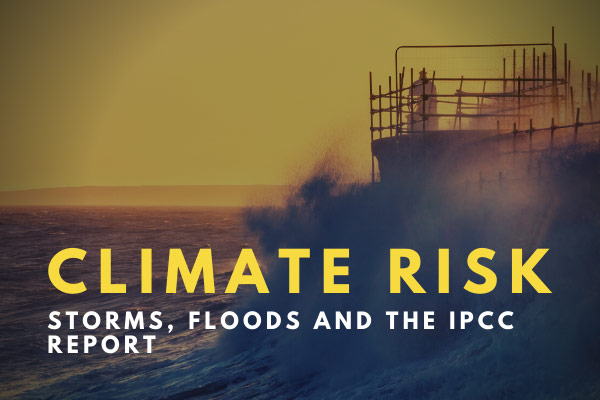Climate Risk is InsTech’s monthly newsletter dedicated to climate-related insurance news – you can sign up for free here.
A month in climate: storms, floods and the IPCC report
The latest IPCC report was released in the same month as several climate-related peril events that have caused widespread damage and huge insurance losses.
Throughout February, two consecutive winter storms hit Europe. Australia is still experiencing severe flooding with insured loss estimates increasing by the day. It is the worst flooding the country has seen in over a decade.
On 28th February, the Working Group II contribution to the IPCC Sixth Assessment Report was released. As well as assessing the impacts of climate change, it also reviews vulnerabilities and the limits of societies to adapt to climate change. The report highlights parametric insurance as a way to improve climate resilience, especially for people such as smallholder farmers. In this issue of Climate Risk, we cover news from parametric-related companies including Descartes Underwriting, MiCRO Insurance and Reask.
€3-5bn insured losses from European winter storms
The estimate from Verisk Extreme Event Solutions (formerly AIR Worldwide) is for insured losses due to wind from winter storms Dudley/Ylenia and Eunice/Zeynep which ended on 19th February. The majority of losses are expected in Germany, UK and the Netherlands. Damage to residential, commercial, industrial, and agricultural properties and automobiles are included in the estimate, as well as business interruption in the UK.
$1.62bn insured losses from Australian floods
As of 9th March, the Insurance Council of Australia (ICA) estimates insured losses to be $1.62 billion. Insurers have now received over 100,000 claims related to the flooding in Southeast Queensland and New South Wales. The ICA states that 80% of total claims across both states are for domestic property, with 17% for motor vehicles and 3% for commercial property. ICEYE has been monitoring the floods from its satellites to obtain flood extent and depth data.
Climate change risk regulation and measurement: 22 companies to know
The latest InsTech report is out now and free to download for a limited period. It examines the opportunities and challenges in reporting insurers’ climate change risk and impact, what is required by regulators, and what companies are out there providing models, tools and analytics. Our online report launch event featuring speakers from Fathom, Reask and Convex is also available to watch on-demand here.
ESG with AXA XL: Behind the scenes
Earlier this year, Matthew Grant was joined by Katie Lennon on the InsTech podcast to talk about all things ESG. Based on their discussion, this article explores the issues around calculating greenhouse gas emissions and opportunities for companies within the ESG space.
Understanding ground risks with Terrafirma – Podcast 179
Matthew Grant was joined by Terrafirma’s Dr Tim Farewell, Director of Science and Communications, to talk about the science behind different ground risks and how insurers are using the company’s data. Tim also explains how climate change is impacting ground risks.
Member spotlight: Descartes Underwriting
InsTech’s Henry Gale speaks to Descartes Underwriting’s team in London about the parametric products the company offers, what climate perils their UK clients need coverage for most, and other trends in parametric insurance.
Liberty partners with Previsico for personalised flood warnings
The partnership will allow Liberty Specialty Markets (LSM) to provide real-time flood warnings to commercial clients. Previsico’s IoT sensors are installed in flood-prone rivers, streams and culverts close to selected risks, allowing LSM’s clients to be notified when there is a risk of flooding. Data from the sensors can also be used by LSM’s claims team.
Parametric agricultural insurance launches in Guatemala
The product has been created to protect smallholder farmers against heavy rain and prolonged droughts. The insurance is automatically activated when excess rainfall or drought reach agreed levels, with different parameters in each region of the country. The product was designed by Microinsurance Catastrophe Risk Organisation (MiCRO). The launch provides coverage for over 6,000 farmers, with the aim to reach 40,000 over 2022.
Fathom to introduce global elevation model without forests and buildings
Fathom has developed FABDEM: a global digital elevation model with forests and buildings removed at 30m. On 10th March Fathom is hosting a webinar to explain how the model was developed and how the data can be applied.
Reask and Descartes Underwriting announce partnership
The partnership will see Descartes use Reask’s wind speed data to expand its parametric cyclone insurance to new locations. Reask’s tropical cyclone product, Metryc, offers consistent global coverage.
RMS launches Southeast Asia flood models
The probabilistic models cover Indonesia, Malaysia, Singapore and Thailand. The models will help (re)insurers to reduce portfolio blind spots occurring from intra- and interseasonal flood events such as tropical storms and monsoons, which caused the 2011 Thailand Floods as well as the recent flooding in Malaysia and Indonesia.
CAPE Analytics: A new approach to wildfire risk assessment
According to CAPE Analytics, 47% of ‘high’ and ‘very high’ risk properties in California have the potential to reduce their vulnerability to wildfire with mitigation practices. The company’s white paper compares risk analysis approaches and highlights the importance of address-level assessments.
Arturo: Artificial intelligence in property and casualty webinar
Climate change is affecting property risk and therefore what can be insured. In this webinar, Arturo’s Neil Pearson and Daniela Moody discuss how artificial intelligence can be used to identify property characteristics and detect changes in risk.
Aon works with JBA to update its Europe windstorm model
According to Aon, windstorms in Europe have caused $123 billion USD of insured losses since 1980. Aon’s Impact Forecasting Europe windstorm catastrophe model now includes storm surge modelling for the UK, as a result of the company’s collaboration with JBA. This is the biggest update to the model since its launch in 2015.


